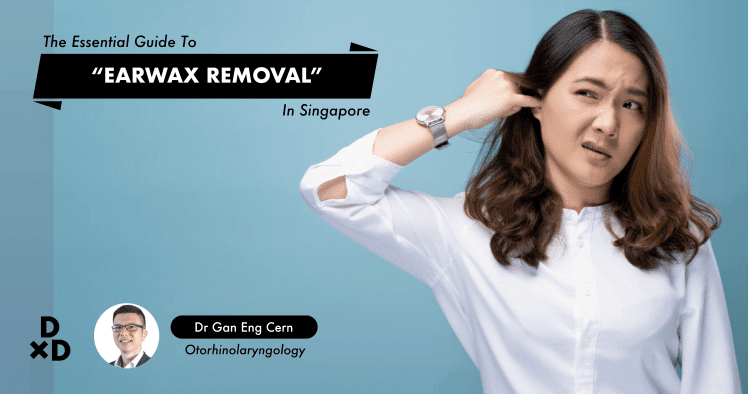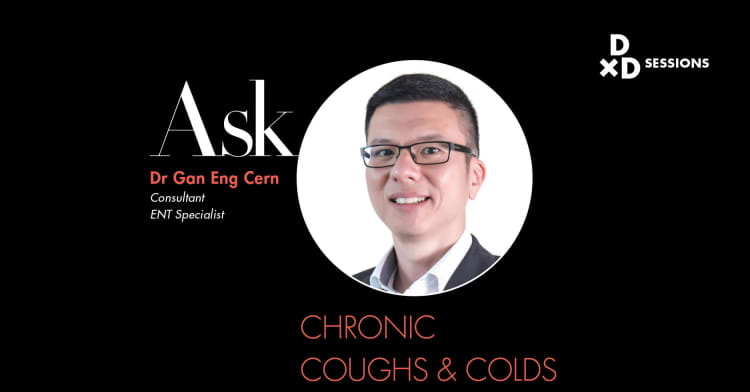We have all been guilty of ear digging. Most of my patients say they do it because they can’t stand the thought of earwax in their ear canal. Others will simply say that ear digging feels “shiok”.
Imagine their surprise when I tell them that the ear canal is a self-cleansing organ which does not need to be cleaned!
Also read: The Complete Guide To Seeing An ENT Specialist In Singapore
Impacted earwax, or earwax buildup, is a common condition seen in my practice.
This post explains all you need to know about earwax removal in Singapore. But first things first….
What can go wrong when you try to clean your ear yourself?
To illustrate a common scenario, I recently saw a patient who complained of ear blockage following what she described as “water getting into the right ear” whilst showering.
She proceeded to “dry out the water” with a cotton bud, but her ear became even more blocked, and she experienced pain after.
I examined her and found that she had impacted earwax in her right ear canal. This was caused by the water entering her ear canal, resulting in the clumping up of earwax (Figure 1a).
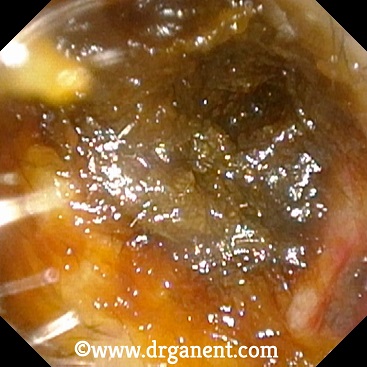
Figure 1a – Impacted earwax as a result of “water getting into the ear”
The earwax had to be removed with a suction tube under microscope guidance.
After removal, a bruise with a small blood collection under the thin skin of the ear canal from her ear digging was seen (Figure 1b).
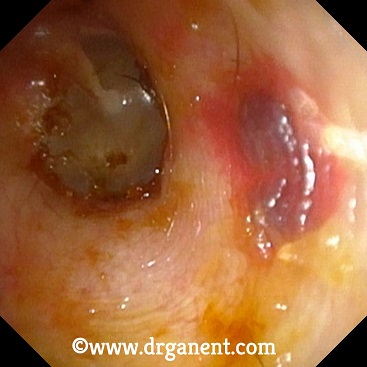
Figure 1b – Bruise and a small collection of blood under the skin resulting from ear digging with a cotton bud
As the skin in the ear canal is very thin and fragile, the lining of the ear is easily damaged during ear digging. Damaged ear canals or eardrum from ear digging also makes you even more prone to ear infections!
I also have many patients come to me with a broken cotton bud tip stuck in their ear canal (Video 1).
Okay, doctor, what is earwax?
Earwax, or the medical term, cerumen, is an oily, waxy substance made from the glands lining the outer part of your ear canal. It consists of fatty secretions and dead skin.
Earwax can range from yellow to brown in colour, and has a wet or dry appearance depending on your genes!
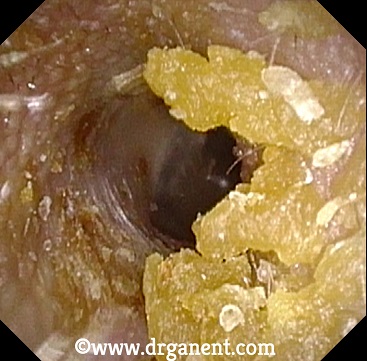
Figure 2a
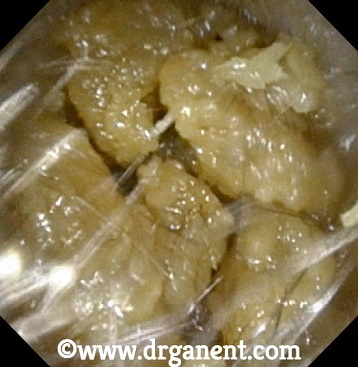
Figure 2b
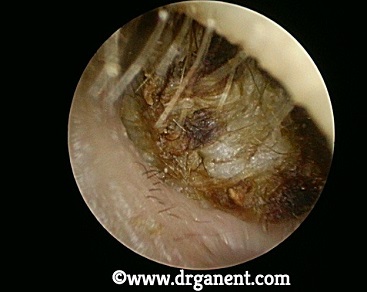
Figure 2c
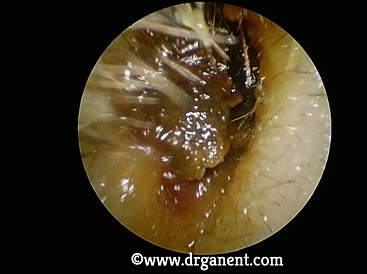
Figure 2d
Figures 2 a-d – Earwax with different colours and consistencies
Do you have to clean out your own earwax?
The answer is a big NO! The ear is a self-cleansing organ.
The lining of the ear canal is like a conveyor belt, constantly moving dead skin and earwax away from your eardrum (Figure 3).
If you place a dot of ink on your eardrum, you will see that ink dot moving outwards towards the external ear canal over a period of weeks.
Moreover, as your jaw joint is located at the base of your ear canal, jaw movements help to dislodge earwax when you talk or chew.
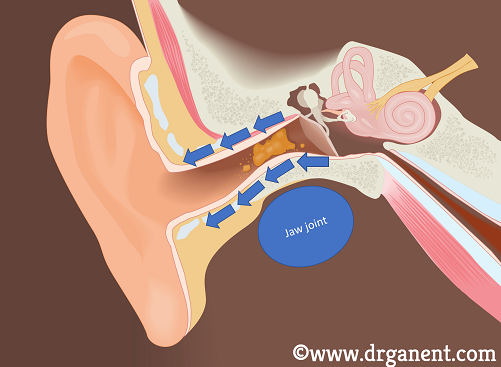
Figure 3 – The lining of the ear canal is like a conveyor belt, moving dead skin, wax and debris away from the eardrum.
What happens when you dig your ears?
Digging your ears with a cotton bud (aka. Q-tips) will only push the earwax deeper into the ear canal and pack it against the eardrum. When this happens, the self-cleansing mechanism of the ear will fail.
The cotton bud is meant to clean the area outside the ear canal, not the inside (Figure 4a-d).
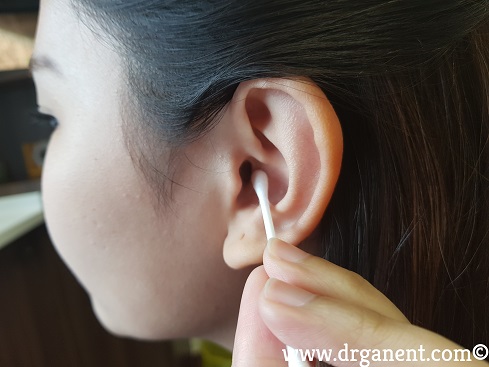
Figure 4a – The cotton bud is meant to clean the skin outside the ear canal
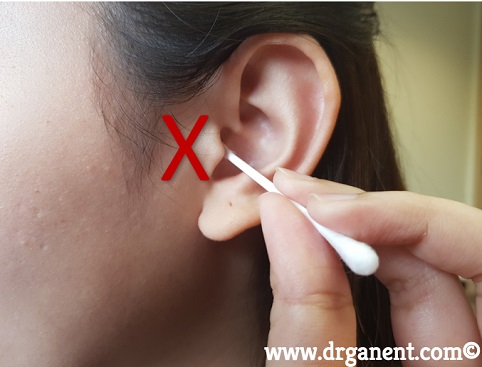
Figure 4b – It should never be inserted into the ear canal
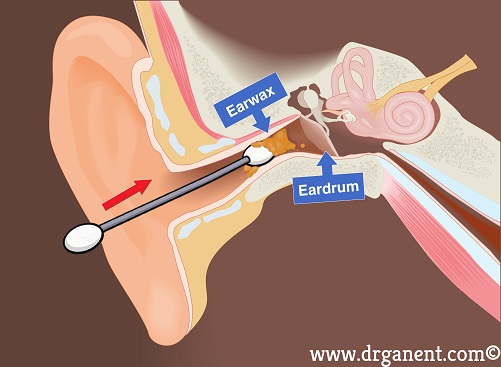
Figure 4c – Inserting a cotton bud into the ear canal will only push the earwax deeper
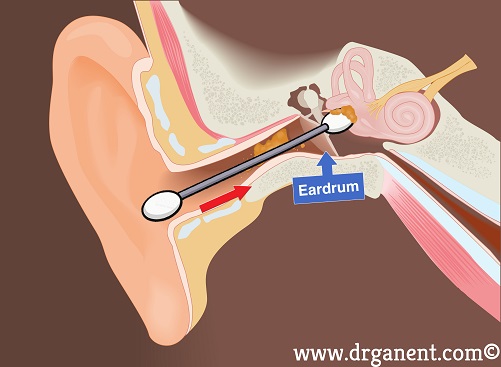
Figure 4d – There is also a risk of puncturing the eardrum or having the tip of the cotton bud break and end up stuck in the ear canal.
Is having earwax in your ear canals bad?
Earwax in small amounts is actually good for your ears. It helps to moisturize your ears, protect them from fungal and bacterial infection, and helps trap dirt and dust from the air.
Like your gut, your ear has a healthy community of organisms which reside in your earwax.
When should you be concerned about earwax?
Most of the time, never! However, there are some conditions or habits that increase the risk of earwax buildup.
These include:
- Regular ear digging (eg. with cotton bud aka Q-tips) – Ear digging results in earwax being pushed deeper into the ear canal. When the earwax is compressed against a narrow part of the ear canal or against the eardrum, the self-cleansing mechanism of the ear will fail. Ear digging can also stimulate more production of earwax.
- Eczema or dry skin (Figure 5) – If the skin just outside the ear canal is dry, it tends to result in more earwax production and earwax buildup.
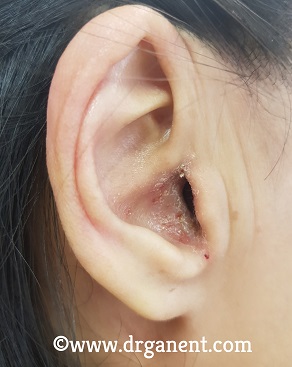
Figure 5 – Eczema just outside the ear canal
- Narrow ear canals – Some people are born with narrower ear canals which may result in the failure of the self-cleansing mechanism.
- Genetic predisposition – Some people are born with a tendency to produce more earwax than others. Moreover, it is known that Caucasians tend to have wetter earwax, while Asians tend to have drier earwax.
- Prolonged use of earplugs or hearing aids – Earplugs or hearing aids can push wax deeper into the ear canal. Wearing earplugs or hearing aids for a long period of time can stimulate more sweat and earwax production, especially in Singapore's warm and humid environment.
- Exposure to polluted air – As earwax helps trap dirt and bacteria, frequent exposure to polluted air may also contribute to earwax buildup.
What are the symptoms of earwax buildup?
Most of the time, earwax, even in large quantities, does not cause any symptoms.
However, when it is impacted, it can cause:
- Hearing loss or ear blockage
- Ear pain
- Ear discharge
- Ear itch
- Tinnitus (a ringing sound in the ear)
- Cough
How can you prevent earwax buildup?
To avoid earwax buildups, some of these measures may help:
- Stop digging your ears!
- Use an earwax softener regularly – 2-3 times a week
- Treat eczema of the ear if it is present
- Avoid prolonged use of earplugs
How can you remove impacted earwax?
DIY home treatments:
Earwax softeners – These can usually be bought from the pharmacy without prescription - they include olive oil, mineral oil, Soluwax and hydrogen peroxide. The correct way to apply earwax softeners is as follows:
- Tilt your head to the side so that the affected ear is facing up.
- Pull your ear backwards to straighten your ear canal
- Apply 3-5 drops of wax softeners into the ear canal
- To ensure that the eardrops enter the canal, do a tragal massage (push the soft bone in front of your ear canal against the opening of the ear canal about 5 times)
- Stay in that position for about 10-20 seconds
- Repeat the process 2-3 times a day for 1-2weeks
Never try to dig your ears on your own, especially with cotton buds, ear picks or metal pins. I’ve had a patient who used a “pen” to dig his ear, resulting in the "pen" tip dislodging in his ear and causing an ear infection (Video 2):
How can your doctor help you to remove earwax?
1. Ear syringing:
Ear syringing is a common and simple procedure done in many GP clinics in Singapore.
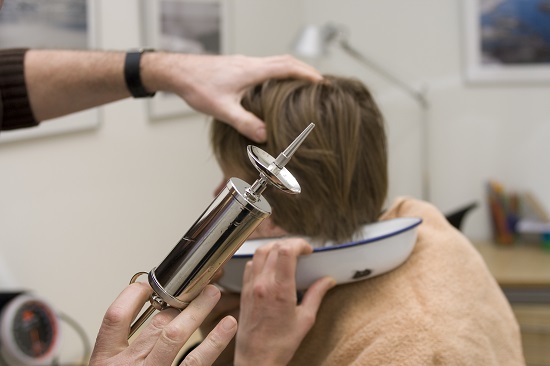
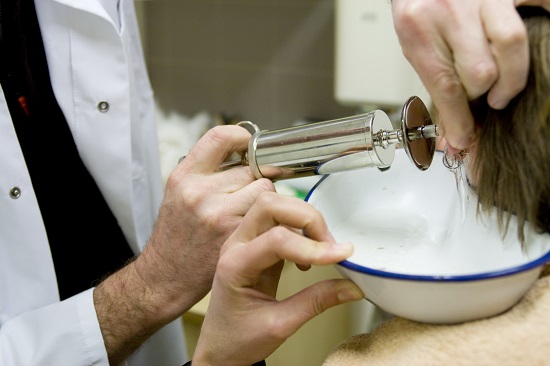
Figure 6 a-b – Ear syringing
How it works:
- Ear syringing involves flushing the ear with warm saline from a syringe and a soft cannula (tube). The earwax will flow out of the canal into a kidney dish or basin to be disposed of.
Pros:
- Simple and relatively safe procedure
- Relatively cheap (~SGD20-SGD30 per ear)
- More accessible as it is performed by many GPs
Cons:
- Can be messy with saline irrigation wetting the patient’s clothes or hair
- Shouldn’t be done if there is a hole in the eardrum (which the doctor can’t tell if your ear canal is full of earwax!)
- Will be painful if there is concurrent active ear infection
- May not be able to clear the impacted earwax completely
- May cause giddiness if the saline used is cold
2. Microsuctioning under microscope or endoscope guidance (medically known as Aural Toilet):
Most ENT specialists remove earwax under the guidance of the microscope (Figure 7) or endoscope. This is what I would recommend for most patients with an impacted earwax.
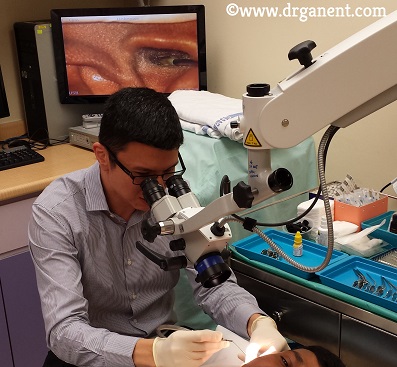
Figure 7 – Aural toilet under microscope guidance
How:
- This usually involves using a “microsuction” or “mini-vacuum” tube to extract earwax in a delicate and precise manner (Figure 8, Video 3). For harder or drier earwax, a small forceps or a small metal hook can be used to extract the earwax.
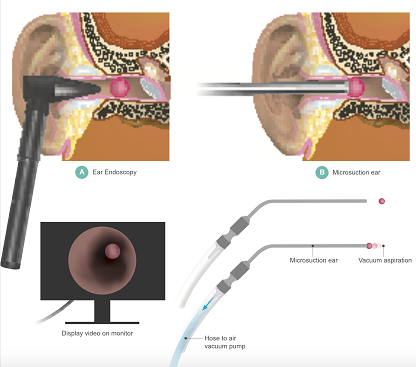
Figure 8 – A microsuction can be used to remove earwax, debris, foreign body or pus (infected fluid) from the ear canal.
Pros:
- The safest, most precise and most delicate method of removing earwax or foreign body in the ear
- Usually painless unless the earwax is hard or very impacted (in such cases, your doctor will advise that you use an ear softener first)
- Magnification from the microscope or endoscope allows complete visualisation of the ear canal and eardrum.
- Usually, no saline or fluid is involved in the process, hence is usually not messy
- Allows concurrent treatment of ear infections if present
Cons:
- More expensive than ear syringing (~SGD 40 to SGD 150 per ear – depending on complexity of the procedure)
- Noise from the suction tube can be annoying or frightening to some
- The suctioning can occasionally cause some temporary giddiness
- Less accessible as mostly performed by ENT specialists only
I have seen spas and beauty salons that offer ear candling to remove ear wax. Does ear candling work?
Ear candling involves the placement of a lighted hollow candle into the patient’s ear. It's thought that the vacuum in the hollow candle created from the burning candle may suck out the earwax.
Ear candling is not recommended for removing impacted earwax, as there is no scientific evidence that it works.
In 2007, the US Food and Drug Administration (FDA) issued a health warning against the use of ear candling.
I’ve seen many cases of the hot wax from the candle causing burn injuries to the face and ear.
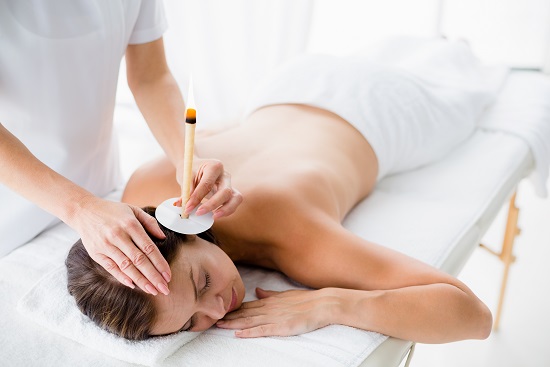
Figure 9 – Ear candling
How can you find a trusted doctor for earwax removal in Singapore?
In finding a doctor to remove your earwax, you should definitely take into consideration the doctor's familiarity with the procedure.
Feel free to ask whether earwax removal is something that's done commonly in their practice when you send in your enquiry to a few trusted doctors on Human!
After all, your hearing is precious, and you should do all you can to ensure a successful outcome.
Dr Gan Eng Cern is an ENT Specialist at Mount Elizabeth Novena Specialist Centre (A Specialist Centre for Sinus, Snoring & ENT), and is also a Senior Clinical Lecturer at the National University of Singapore. He obtained Subspecialty training in Nose and Sinuses, and has a passion for the treatment of snoring and Obstructive Sleep Apnoea (OSA). Dr Eng Cern enjoys jogging regularly to keep his spare tyres under control.
